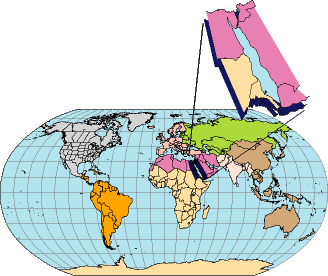
![]()
U.S. DEPARTMENT OF THE INTERIOR
U.S. GEOLOGICAL SURVEY
The Red Sea Basin Province: Sudr-Nubia(!) and Maqna(!) Petroleum Systems¹
Sandra J. Lindquist, Consultant to
U.S. Geological Survey, Denver, CO
World Energy Project
October, 1998

USGS Open-File Report 99-50-A
|
FOREWORD FIGURES 1. Pre-rift
Red Sea stratigraphy TABLES 1. Fields and reserves
by petroleum system This report is a product of the World Energy Project of the U.S. Geological Survey, in which the world has been divided into 8 regions and 937 geologic provinces for purposes of assessment of global oil and gas resources (Klett and others, 1997). These provinces have been ranked according to the discovered petroleum volumes within each; high-ranking provinces (76 "priority" provinces exclusive of the U.S.) and others with varying types and degrees of intrigue (26 "boutique" provinces exclusive of the U.S.) were chosen for appraisal of oil and gas resources. The petroleum geology of these non-U.S. priority and boutique provinces are described in this series of reports. A detailed report containing the assessment results for all provinces will be available separately. The Total Petroleum System concept is the basis for this assessment. A total petroleum system includes the essential elements and processes, as well as all genetically related hydrocarbons that occur in petroleum shows, seeps and accumulations (discovered and undiscovered), whose provenance is a pod or related pods of mature source rock (concept modified from Magoon and Dow, 1994). The minimum petroleum system is that portion of the total petroleum system for which the presence of essential elements and processes has been proved. The assessment unit is a mappable volume of rock within the total petroleum system, sufficiently homogeneous in terms of geology, exploration strategy and risk characteristics to constitute a single population with respect to criteria used for the chosen methodology of resource assessment. Assessment units are considered established if they contain more than 13 fields, frontier if they contain 1-13 fields and hypothetical if they contain no fields. A unique, eight-digit numeric code identifies each assessment unit with respect to region, province, and petroleum system. The first digit is the region number, the next three digits the province number, the next two digits the total petroleum system number, and the final two digits the assessment unit number. The codes for the regions and provinces were established, listed and mapped in Klett and others, 1997. Figures in this report that show boundaries of total petroleum systems, assessment units, and pods of active source rock were compiled using geographic information information (GIS) software. Political boundaries and cartographic representations on these figures were taken with permission from ESRI's (Environmental Systems Research Institute, Inc.) ArcWorld 1:3 million digital coverage. The boundaries have no political significance and are displayed for general reference only. Oil and gas field centerpoints shown on these figures are reproduced with permission from Petroconsultants, 1996. Also included as a figure is an events chart that shows the time of deposition of essential rock units; the time processes (such as trap formation) necessary for the accumulation of hydrocarbons; the critical moment in the petroleum system; and the preservation time. The format is that proposed by Magoon and Dow (1994). _____________________ |
U.S. Geological Survey Open-File Report 99-50-A